The Dambulla Caves

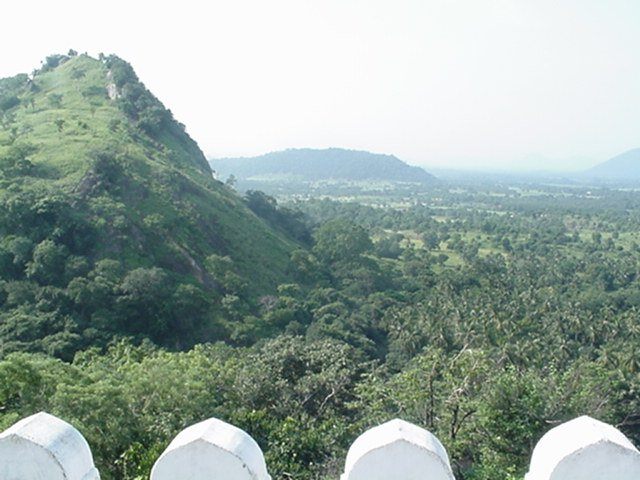 While not quite on a par
with climbing the 463 steps of the Duomo in Florence or walking down
700 steps into the birthplace of the Rajasthani warriors at India's Mt.
Abu, the climb up to the Dambulla caves is still a fairly strenuous
hike. The ascent begins at the Las Vega-style greeting center. The
photo to the left shows the initial phase of the climb, up a
cobblestone walkway from the visitor's center and parking lot. Soon
visitors are high enough to get a view of the expansive plains below.
The photo to the right shows a vista from a point about three-quarters
of the way up the hill. From there one can see the rock fortress of
Sigiriya on a clear day. Once you reach the summit, shoes are removed
and you pass through an entry gate that leads to the main courtyard.
The photo at the lower left shows the view looking from the center of
the courtyard back toward the entryway. Prayer banners abound, as do
the monkeys who are
While not quite on a par
with climbing the 463 steps of the Duomo in Florence or walking down
700 steps into the birthplace of the Rajasthani warriors at India's Mt.
Abu, the climb up to the Dambulla caves is still a fairly strenuous
hike. The ascent begins at the Las Vega-style greeting center. The
photo to the left shows the initial phase of the climb, up a
cobblestone walkway from the visitor's center and parking lot. Soon
visitors are high enough to get a view of the expansive plains below.
The photo to the right shows a vista from a point about three-quarters
of the way up the hill. From there one can see the rock fortress of
Sigiriya on a clear day. Once you reach the summit, shoes are removed
and you pass through an entry gate that leads to the main courtyard.
The photo at the lower left shows the view looking from the center of
the courtyard back toward the entryway. Prayer banners abound, as do
the monkeys who are  clearly
used to interacting (being fed) by visitors. The photo to the lower
right looks the other direction from the courtyard. The white buildings
built under the mountain's outcropping are the entrances to the
five Dambulla Caves. Some are natural, some are man-made; most
clearly
used to interacting (being fed) by visitors. The photo to the lower
right looks the other direction from the courtyard. The white buildings
built under the mountain's outcropping are the entrances to the
five Dambulla Caves. Some are natural, some are man-made; most 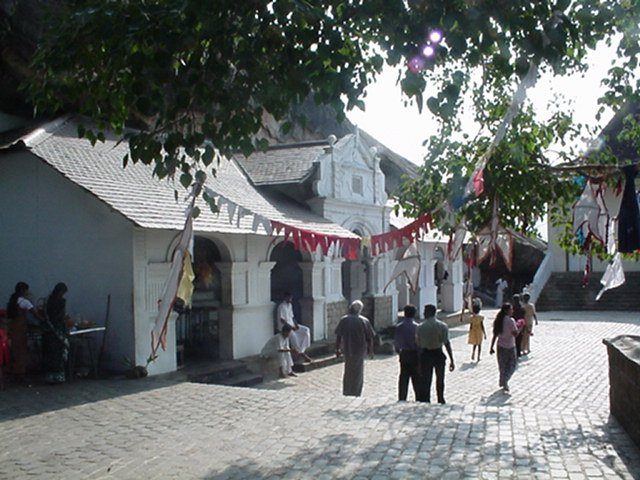 seem to
have been natural formations enlarged by the monks over the centuries.
Inscriptions from as early as the first century B.C. make mention of
the Dambulla Caves; when invaders overran King Abhaya's complex at
Anuradhapura, he sought protection and was given refuge by the resident
monks.
seem to
have been natural formations enlarged by the monks over the centuries.
Inscriptions from as early as the first century B.C. make mention of
the Dambulla Caves; when invaders overran King Abhaya's complex at
Anuradhapura, he sought protection and was given refuge by the resident
monks.

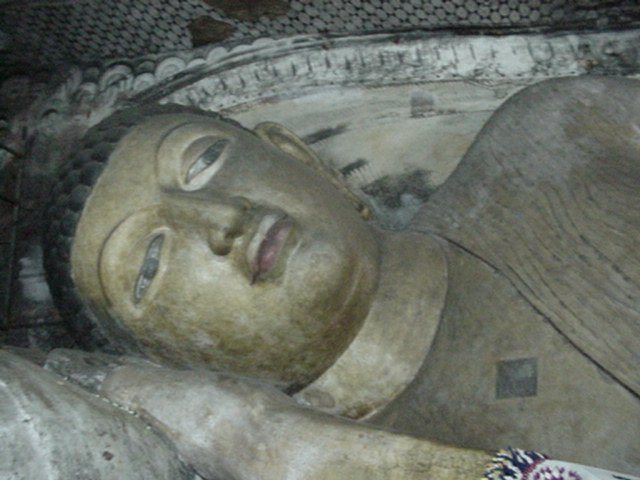 Entrance to the Dambulla caves is gained through the
walkway shown in the previous set of photos. The image to the left
shows the small stupa at the beginning of the walkway, near the
entrance to Cave 1. Cave 1 is known as The Temple of the King of the
Gods because it was believed that Sakka,
the king of the Gods,
put the
finishing touches to the principal statue within it. This image depicts
the
Parinibbana or the passing away of the Buddha (photo to the left). The statue is typical of late Anuradhapura sculpture. It
is about 47 ft. in length. The face is almost
expressionless, while the
hair
is schematically shown by a series of dots. The fine-textured robe is
depicted by a series of grooves
arranged
closely in pairs. The
whole figure is executed in the round out of the
existing rock and
is joined to the rock wall along the back. This cave holds five
other images. Of these the one at the southern end of the room is said
to be of Arahat Ananda, the Buddhas attendant-at-arms, weeping at the
death of the Master. At the northern end, facing the principal image,
is a statue identified as Vishnu by
some scholars and as Upulvan by others, one of the four guardian
deities of the Island. This figure has been very
Entrance to the Dambulla caves is gained through the
walkway shown in the previous set of photos. The image to the left
shows the small stupa at the beginning of the walkway, near the
entrance to Cave 1. Cave 1 is known as The Temple of the King of the
Gods because it was believed that Sakka,
the king of the Gods,
put the
finishing touches to the principal statue within it. This image depicts
the
Parinibbana or the passing away of the Buddha (photo to the left). The statue is typical of late Anuradhapura sculpture. It
is about 47 ft. in length. The face is almost
expressionless, while the
hair
is schematically shown by a series of dots. The fine-textured robe is
depicted by a series of grooves
arranged
closely in pairs. The
whole figure is executed in the round out of the
existing rock and
is joined to the rock wall along the back. This cave holds five
other images. Of these the one at the southern end of the room is said
to be of Arahat Ananda, the Buddhas attendant-at-arms, weeping at the
death of the Master. At the northern end, facing the principal image,
is a statue identified as Vishnu by
some scholars and as Upulvan by others, one of the four guardian
deities of the Island. This figure has been very
 cleverly worked.
This cave also contains many wall
and ceiling paintings.
cleverly worked.
This cave also contains many wall
and ceiling paintings.
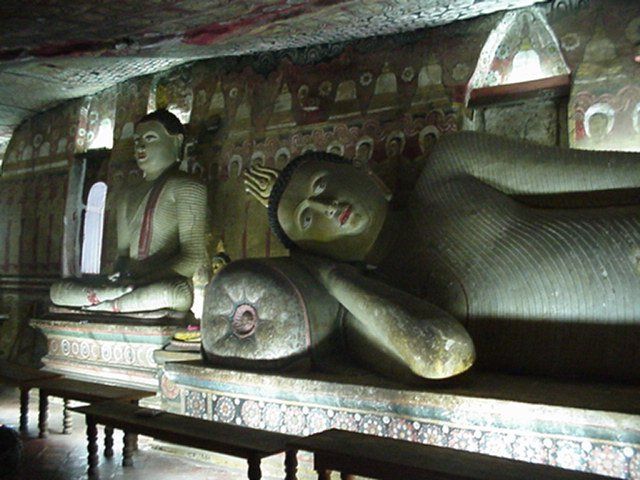
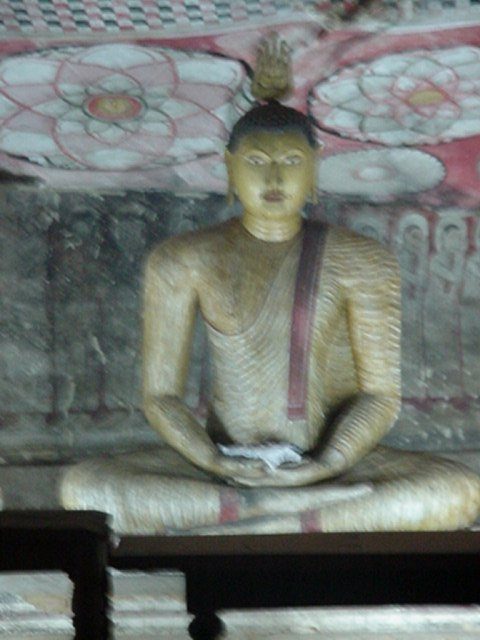 Cave
2, The
Temple of the Great King, is
the largest and the most impressive
cave in
the complex. The front portal is a lofty archway guarded on either side
by "Makara" figures executed in stone. According to current lore, this
shrine was founded by the Great king Vattagamini Abhaya. The paintings
and sculptures here
are well conceived. The cave is seventy-two feet long, seventy five
feet
wide, and
twenty one feet high at the entrance. The roof is arched and slopes
down towards the back wall. This cave contains fifty three images. Most
of them
are
of
the
Buddha, in
different attitudes, shown by different
mudras
(postures). Many of the statues are well proportioned,
and
larger than life size; the
smallest
of them are
human size. The photo to the
left shows the figure of the recumbent Buddha near the outer wall,
while the image to the right is one of a row of images that form a
gallery between the wall and the other figures.
The entire wall surface of the cave is a mosaic of
brilliantly colored paintings. in which yellow is predominant. The
ceiling nearest the entrance has been used to display paintings of the
life of the Buddha, before and after Enlightenment.
Cave
2, The
Temple of the Great King, is
the largest and the most impressive
cave in
the complex. The front portal is a lofty archway guarded on either side
by "Makara" figures executed in stone. According to current lore, this
shrine was founded by the Great king Vattagamini Abhaya. The paintings
and sculptures here
are well conceived. The cave is seventy-two feet long, seventy five
feet
wide, and
twenty one feet high at the entrance. The roof is arched and slopes
down towards the back wall. This cave contains fifty three images. Most
of them
are
of
the
Buddha, in
different attitudes, shown by different
mudras
(postures). Many of the statues are well proportioned,
and
larger than life size; the
smallest
of them are
human size. The photo to the
left shows the figure of the recumbent Buddha near the outer wall,
while the image to the right is one of a row of images that form a
gallery between the wall and the other figures.
The entire wall surface of the cave is a mosaic of
brilliantly colored paintings. in which yellow is predominant. The
ceiling nearest the entrance has been used to display paintings of the
life of the Buddha, before and after Enlightenment.
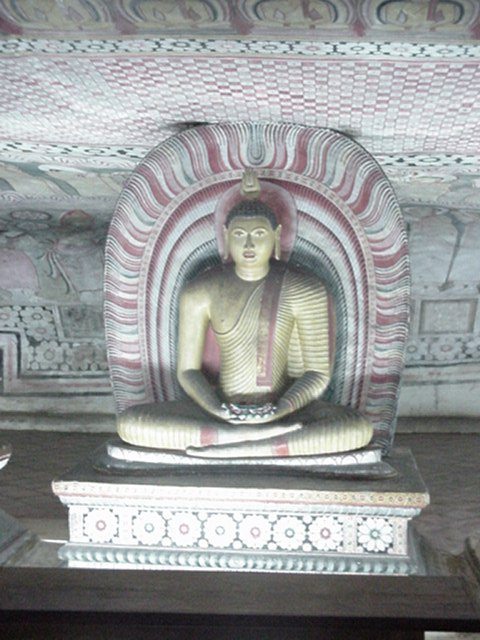
Cave 3,
the
Great New Temple, is
separated from
Cave 2
by
a masonry wall. This cave is said to have been used as store room
until the 18th century. The cave is about ninety feet long, and
eighty
one feet wide; its ceiling is shelving rock, about thirty six feet high, making it the
second largest cave. The vast rock surface is painted in rich colors
and
it is
ornamented with murals executed in the tradition of the Kandyan period
of
art.
The frescoes depict events in Buddhist history.
as well as the
life of the Buddha.
Altogether
this cave houses fifty images of the Buddha. The principle image is a
standing figure facing the entrance placed under a "thorama" or ornate
gateway.
(photo to the
left)
Both image and gateway are carved out of the natural
rock.
Another
notable sculpture is the figure of the recumbent Buddha:
It
is about thirty feet in length. and very well proportioned. The face is
handsome, and the sculptor has cleverly worked his medium so that the
face holds an expression of remarkable
peace
and
tranquility..
Considering that the medium is hard granite the achievement is
noteworthy both artistically and technically. There are seven standing
images, each
about ten feet tall. The others are life-size or a little smaller. The
greater number are painted yellow, while there are robes in red. This
cave
features the
Kandyan approach to art and sculpture.
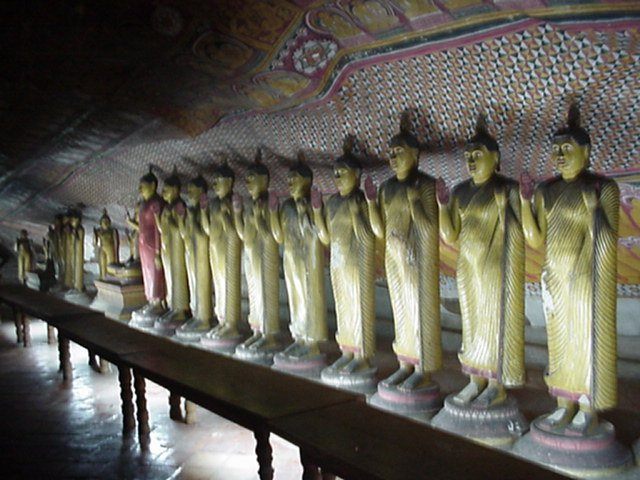
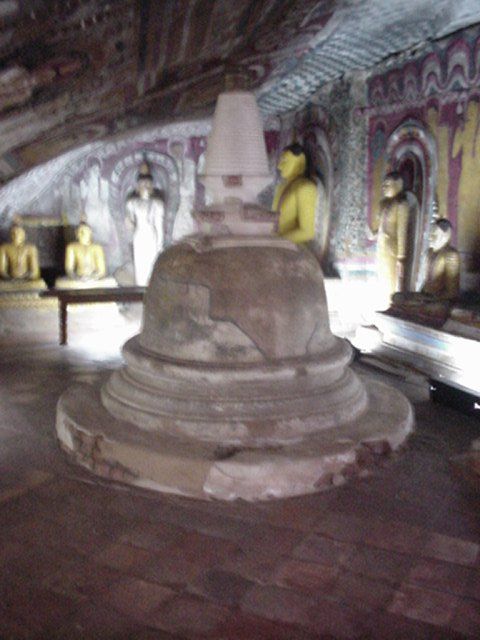 Cave
4 is named the Western Temple. It is about fifty feet long. and
twenty feet wide. The roof is about twenty seven feet high. and dips
steeply towards the back wall. This cave has ten figures of the Buddha
all of equal size and proportion.
(photo
to the left)
The principal sedant figure is placed under a Thorana.
an archway. in the classical posture of meditation. This statue, hewn out of the rock, is painted
in the brilliant colours of the Kandyan period of
painting and remains in a very fine state of preservation. The other images placed in two rows to the right
and left of the principal
image
are cut out of the rock
and are painted in
bright colours. Most of them are of human proportion,
while a few are larger.
Cave
4 is named the Western Temple. It is about fifty feet long. and
twenty feet wide. The roof is about twenty seven feet high. and dips
steeply towards the back wall. This cave has ten figures of the Buddha
all of equal size and proportion.
(photo
to the left)
The principal sedant figure is placed under a Thorana.
an archway. in the classical posture of meditation. This statue, hewn out of the rock, is painted
in the brilliant colours of the Kandyan period of
painting and remains in a very fine state of preservation. The other images placed in two rows to the right
and left of the principal
image
are cut out of the rock
and are painted in
bright colours. Most of them are of human proportion,
while a few are larger.
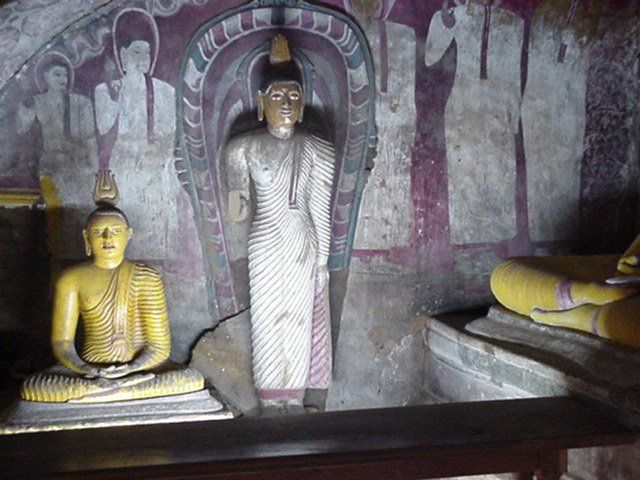
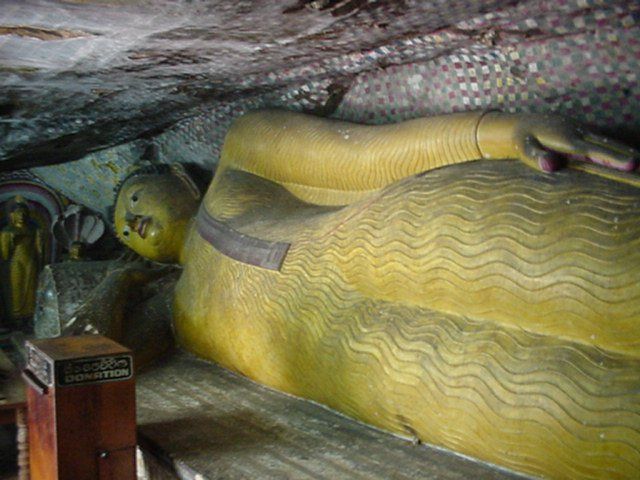 Cave 5,
called Devana Alut Viharaya (I could find no
English equivalent) is
the smallest of all shrine rooms of the Dambulla Rock Temple. This was
made a shrine room by a local chieftain in the beginning of this
century .This cave consists of a
natural rock roof and four built-up
walls. It has a painted area of 69.5 square
metres. The width of it is roughly 6.8 metres and the length is roughly
12.25 metres. The seats of the Buddha statues are
built with blocks and rubble similar to those used in building the
walls. There are eleven statues in this cave and the principal image is the recumbent Buddha.
(photo
to the right)
This
image takes a more prominent place than the other ten statues, for it
shows a higher degree of workmanship.
At the
Buddha's
Cave 5,
called Devana Alut Viharaya (I could find no
English equivalent) is
the smallest of all shrine rooms of the Dambulla Rock Temple. This was
made a shrine room by a local chieftain in the beginning of this
century .This cave consists of a
natural rock roof and four built-up
walls. It has a painted area of 69.5 square
metres. The width of it is roughly 6.8 metres and the length is roughly
12.25 metres. The seats of the Buddha statues are
built with blocks and rubble similar to those used in building the
walls. There are eleven statues in this cave and the principal image is the recumbent Buddha.
(photo
to the right)
This
image takes a more prominent place than the other ten statues, for it
shows a higher degree of workmanship.
At the
Buddha's 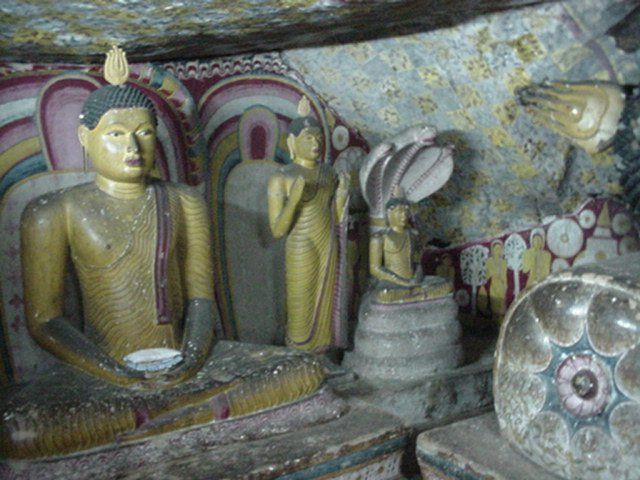 head lies a shrine featuring a sitting Buddha and a hooded
Buddha (photos to the left and bottom).
head lies a shrine featuring a sitting Buddha and a hooded
Buddha (photos to the left and bottom).

Return to Dambulla Main Page

 While not quite on a par
with climbing the 463 steps of the Duomo in Florence or walking down
700 steps into the birthplace of the Rajasthani warriors at India's Mt.
Abu, the climb up to the Dambulla caves is still a fairly strenuous
hike. The ascent begins at the Las Vega-style greeting center. The
photo to the left shows the initial phase of the climb, up a
cobblestone walkway from the visitor's center and parking lot. Soon
visitors are high enough to get a view of the expansive plains below.
The photo to the right shows a vista from a point about three-quarters
of the way up the hill. From there one can see the rock fortress of
Sigiriya on a clear day. Once you reach the summit, shoes are removed
and you pass through an entry gate that leads to the main courtyard.
The photo at the lower left shows the view looking from the center of
the courtyard back toward the entryway. Prayer banners abound, as do
the monkeys who are
While not quite on a par
with climbing the 463 steps of the Duomo in Florence or walking down
700 steps into the birthplace of the Rajasthani warriors at India's Mt.
Abu, the climb up to the Dambulla caves is still a fairly strenuous
hike. The ascent begins at the Las Vega-style greeting center. The
photo to the left shows the initial phase of the climb, up a
cobblestone walkway from the visitor's center and parking lot. Soon
visitors are high enough to get a view of the expansive plains below.
The photo to the right shows a vista from a point about three-quarters
of the way up the hill. From there one can see the rock fortress of
Sigiriya on a clear day. Once you reach the summit, shoes are removed
and you pass through an entry gate that leads to the main courtyard.
The photo at the lower left shows the view looking from the center of
the courtyard back toward the entryway. Prayer banners abound, as do
the monkeys who are  clearly
used to interacting (being fed) by visitors. The photo to the lower
right looks the other direction from the courtyard. The white buildings
built under the mountain's outcropping are the entrances to the
five Dambulla Caves. Some are natural, some are man-made; most
clearly
used to interacting (being fed) by visitors. The photo to the lower
right looks the other direction from the courtyard. The white buildings
built under the mountain's outcropping are the entrances to the
five Dambulla Caves. Some are natural, some are man-made; most  seem to
have been natural formations enlarged by the monks over the centuries.
Inscriptions from as early as the first century B.C. make mention of
the Dambulla Caves; when invaders overran King Abhaya's complex at
Anuradhapura, he sought protection and was given refuge by the resident
monks.
seem to
have been natural formations enlarged by the monks over the centuries.
Inscriptions from as early as the first century B.C. make mention of
the Dambulla Caves; when invaders overran King Abhaya's complex at
Anuradhapura, he sought protection and was given refuge by the resident
monks.
 Entrance to the Dambulla caves is gained through the
walkway shown in the previous set of photos. The image to the left
shows the small stupa at the beginning of the walkway, near the
entrance to Cave 1. Cave 1 is known as The Temple of the King of the
Gods because it was believed that Sakka,
the king of the Gods,
put the
finishing touches to the principal statue within it. This image depicts
the
Parinibbana or the passing away of the Buddha (photo to the left). The statue is typical of late Anuradhapura sculpture. It
is about 47 ft. in length. The face is almost
expressionless, while the
hair
is schematically shown by a series of dots. The fine-textured robe is
depicted by a series of grooves
arranged
closely in pairs. The
whole figure is executed in the round out of the
existing rock and
is joined to the rock wall along the back. This cave holds five
other images. Of these the one at the southern end of the room is said
to be of Arahat Ananda, the Buddhas attendant-at-arms, weeping at the
death of the Master. At the northern end, facing the principal image,
is a statue identified as Vishnu by
some scholars and as Upulvan by others, one of the four guardian
deities of the Island. This figure has been very
Entrance to the Dambulla caves is gained through the
walkway shown in the previous set of photos. The image to the left
shows the small stupa at the beginning of the walkway, near the
entrance to Cave 1. Cave 1 is known as The Temple of the King of the
Gods because it was believed that Sakka,
the king of the Gods,
put the
finishing touches to the principal statue within it. This image depicts
the
Parinibbana or the passing away of the Buddha (photo to the left). The statue is typical of late Anuradhapura sculpture. It
is about 47 ft. in length. The face is almost
expressionless, while the
hair
is schematically shown by a series of dots. The fine-textured robe is
depicted by a series of grooves
arranged
closely in pairs. The
whole figure is executed in the round out of the
existing rock and
is joined to the rock wall along the back. This cave holds five
other images. Of these the one at the southern end of the room is said
to be of Arahat Ananda, the Buddhas attendant-at-arms, weeping at the
death of the Master. At the northern end, facing the principal image,
is a statue identified as Vishnu by
some scholars and as Upulvan by others, one of the four guardian
deities of the Island. This figure has been very
 cleverly worked.
This cave also contains many wall
and ceiling paintings.
cleverly worked.
This cave also contains many wall
and ceiling paintings.








